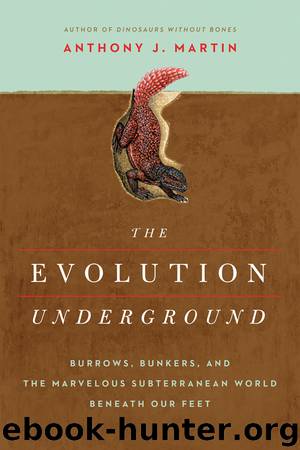The Evolution Underground by Anthony J. Martin

Author:Anthony J. Martin
Language: eng
Format: epub
Publisher: Pegasus Books
Published: 2017-03-20T16:00:00+00:00
Here we have an instance of that inability to sum up the effects of a continually recurrent cause, which has often retarded the progress of science, as formerly in the case of geology, and more recently in that of the principle of evolution.
In his book, Darwin also described and showed illustrations of earthworm traces, such as their burrows, estivation chambers, fecal pellets, and turrets. He describes their burrows going as deep as 2–2.5 meters (6.5–8 feet), with many ending in enlarged chambers, where he presumed worms curled up and overwintered. These burrows and chambers also contained seeds, hinting at the powerful role of earthworm in burying these and otherwise helping seed-bearing plants to germinate and propagate. Darwin even noted the orientations and species of leaves earthworms pulled into their burrows to plug them.
Although soft-bodied earthworms have a poor body fossil record, we know through molecular clocks and fossils that annelids likely originated just after the Ediacaran Period, and modern-style earthworms evolved before the end of the Cretaceous. In the Paleozoic Era, oligochaetes descended from a branch of marine polychaetes, and body fossils in Permian rocks (about 260 million years old) give us a minimum time for when such annelids began living in freshwater and terrestrial environments. Earthworm trace fossils also help fill gaps in their history as burrowers. For example, in a 2007 study that surely would have pleased Darwin, Mariano Verde and several other South American paleontologists described fossil examples of fecal pellets and estivation chambers from geologically young (less than 1 million years old) Pleistocene rocks of Uruguay. Estivation chambers point toward how earthworms behave much like some lungfishes and amphibians during droughts. Worms make these life-sustaining spaces by pasting fecal pellets around them, like laying down bricks and mortar. Once sealed in, they slow down their metabolism and go into diapause. Chambers, which are connected to burrows as escape routes, keep their earthworm occupiers moist even as the soil outside dries. As noted by Darwin, these chambers also serve as refuges from cold temperatures, allowing earthworms to live through cold winters, even near the poles.
Did such strategies work for earthworms in the geologic past? Apparently so. In 2013, ichnologist Karen Chin and a few colleagues documented fossil earthworm burrows and feces from just above the end-Cretaceous boundary. This evidence showed that earthworms, by staying below, survived in enough numbers to begin altering the soils of a post-extinction world. Also, if any modern-day robin or mole could speak, it would tell us how much it appreciates the caloric and nutritional value of earthworms. In other words, earthworms that survived the mass extinction at the end of the Cretaceous enabled soils to recover while also supplying smaller, carnivorous vertebrates—such as burrowing mammals and birds—with enough food so that they could live and propagate.
Fast-forward to the twenty-first century, when modern biologists, using tools that Horace Darwin could not have imagined outside of a steampunk fantasy, documented more of the awesome effects of earthworms. In a 2016 study by Anne Zangerlé
Download
This site does not store any files on its server. We only index and link to content provided by other sites. Please contact the content providers to delete copyright contents if any and email us, we'll remove relevant links or contents immediately.
Sapiens: A Brief History of Humankind by Yuval Noah Harari(13051)
The Tidewater Tales by John Barth(12029)
Do No Harm Stories of Life, Death and Brain Surgery by Henry Marsh(6336)
Mastermind: How to Think Like Sherlock Holmes by Maria Konnikova(6234)
The Thirst by Nesbo Jo(5785)
Why We Sleep: Unlocking the Power of Sleep and Dreams by Matthew Walker(5641)
Sapiens by Yuval Noah Harari(4535)
Life 3.0: Being Human in the Age of Artificial Intelligence by Tegmark Max(4507)
The Longevity Diet by Valter Longo(4445)
The Rules Do Not Apply by Ariel Levy(3905)
The Immortal Life of Henrietta Lacks by Rebecca Skloot(3826)
The Body: A Guide for Occupants by Bill Bryson(3800)
Why We Sleep by Matthew Walker(3771)
Animal Frequency by Melissa Alvarez(3754)
Yoga Anatomy by Kaminoff Leslie(3701)
Barron's AP Biology by Goldberg M.S. Deborah T(3631)
The Hacking of the American Mind by Robert H. Lustig(3579)
All Creatures Great and Small by James Herriot(3515)
Yoga Anatomy by Leslie Kaminoff & Amy Matthews(3394)
